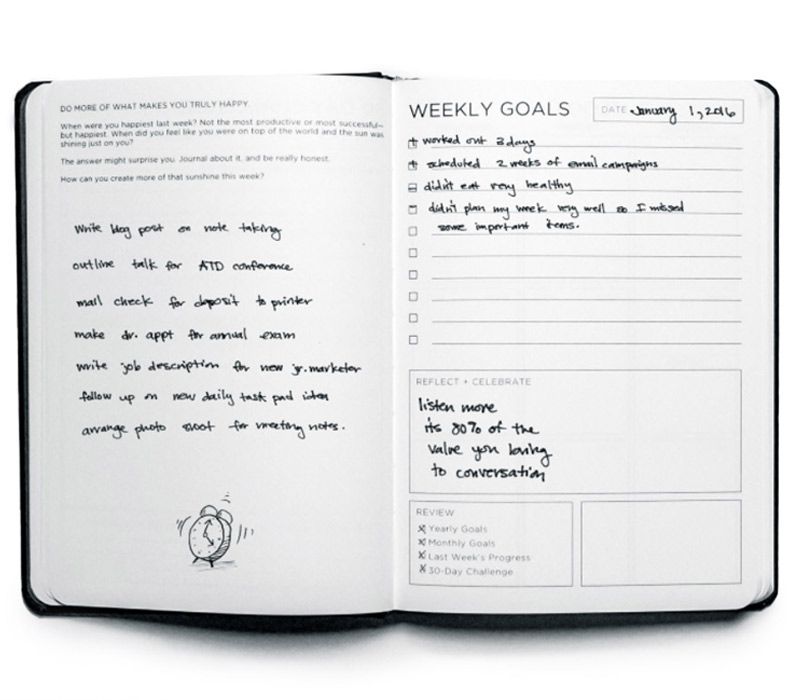الأدوات التي تساعدك على البقاء منظمًا مثل الأعشاب الضارة - تظهر أدوات جديدة كل يوم.
إذا كنت تتطلع إلى البقاء منظمًا، يمكنك حرفيًا تجربة أداة مختلفة من الأحد إلى السبت وقد لا تقترب من هدفك.
جزء من استخدام الأدوات والتقنيات هو طريقة تفكيرك. عليك أن تعمل الأداة لكي تعمل الأداة معك.
ماذا أعني بذلك؟
إنه يعني أن تجربها بشكل حقيقي، وتضيف إليها مهامك وملاحظاتك وخططك وتذكيراتك لترى ما إذا كانت تعمل أم لا.
بعض الناس يفضلون أن يكونوا منظمين مع التطبيقات الرقمية فقط ؛ بينما يفضل آخرون الأدوات التناظرية مع الخيارات الرقمية.
لكن الهدف من أي أداة - رقمية أو تناظرية - هو مساعدتك في تتبع كل شيء.

أحيانًا يكون لكل منا تفضيلاته الخاصة لذلك.
المفتاح هو عدم ترك أي شيء يسقط من خلال الشقوق.
بالنسبة لي شخصيًا، أستخدم مزيجًا من الأدوات الرقمية والتناظرية وسأسلط الضوء على بعض منها أدناه.
## أدوات تنظيمية رقمية ضرورية
1) برامج إدارة المشاريع مثل## برامج إدارة المشاريع مثل كليك أب كيف يحصل ClickUp على
مراجعات رائعة ?
ما الذي يميزه عن كل تلك أدوات الإنتاجية وأنظمة إدارة المشاريع المتوفرة؟
- المرونة والتخصيص
- مصممة للعمل عبر المؤسسة
- جرّب الشلال والرشيق وأي شيء بينهما
البعض الآخر مثل أداة إدارة المهام الشخصية أو لـ إنجاز الأمور المنهجية
مكافأة:
/مرجع/ https://clickup.com/blog/gtd-apps//** برنامج GTD _/%!**_
!
## أدوات تنظيمية تناظرية ضرورية

في رأيي أن أحد الأشياء التي أصبحت مفقودة في ثقافتنا الحالية هي التوصية بالمنتجات التناظرية أو المادية إلى جانب تلك التوصيات الرقمية.
فمن الأسهل كثيرًا جعل الأدوات الرقمية "منتشرة" أو شيء من هذا القبيل، ولكن تم وضع الاثنين في مواجهة بعضهما البعض بشكل غير عادل. يستخدم العديد من الأشخاص المخططات اليومية والدفاتر والمذكرات والمذكرات جنبًا إلى جنب مع أدواتهم الرقمية للقيام بعملهم.
يتعاون الناس مع مزيج من الأدوات والخيارات المختلفة بما في ذلك تلك التي يمكنك لمسها. في هذا القسم، سوف نلقي نظرة على بعض أدوات الإنتاجية التناظرية لمساعدتك في الحفاظ على التنظيم.
8) مخطط يومي مثل حبر + فولت مخطط Ink + Volt هو أحد المخططات المفضلة لدي. إنه متين، ويبدو جميلاً (ولكن ليس متعلقاً بالشركات) ويركز بوضوح على الأهداف - بما في ذلك الأهداف الشهرية والأسبوعية واليومية.
إنه يعطيني رؤية واسعة لحياتي - من اجتماعات العمل إلى المواعيد الشخصية - ويساعدني على تحديد الأهداف الشخصية وأهداف العمل. إنه مزيج رائع لتحقيق النجاح في كلا المجالين.
يقدم مخطط Ink + Volt أيضًا تحديات شهرية لمساعدتك على تحسين جودة حياتك.
خيارات أخرى موصى بها:
9) مجلة مثل ليوشتورم1917 
ماذا، لا يوجد موليسكين؟ كلا، الصفحات الفارغة في الخارج والنقاط في الداخل. يتجه مدونو الملاحظات المخلصون إلى هذه المذكرة لأنها حرفياً أسهل بكثير في توصيل النقاط.
تمنح النقاط الكتاب فصلًا طبيعيًا بين السطور والأفكار. كما أن إنشاء الأعمدة أسهل بكثير.
هذه النقاط رائعة أيضًا لـ اليومية النقطية جنون
خيارات أخرى:
- بوكول
10) بطاقات الفهرسة والملاحظات اللاصقة
إذا كنت ترغب في اتباع نظام تنظيمي تناظري، فستحتاج إلى بطاقات فهرسة و ملاحظات لاصقة . ستكون مفيدة لكتابة الملاحظات والتذكيرات السريعة، وحتى تحديد الأهداف.
بطاقات الفهرسة ليست سميكة جدًا، لذا يمكنك الاحتفاظ بها في حاشية دفتر يومياتك وأخذها معك. يمكن أن تبقى الملاحظات اللاصقة بجانب حاسوبك وتساعدك على ترك تذكيرات للآخرين.
حتى أن بعض الأشخاص استخدام بطاقات الفهرس لإنشاء بطاقات الفهرس الخاصة بهم نظام GTD والذي ... مرة أخرى ... لا ننصح به بالضرورة.
تعد بطاقات الفهرسة والملاحظات اللاصقة رائعة للعصف الذهني والتفكير، لكنني لن أثق بها لإدارة جميع تفاصيل مشروعك حقًا. في النهاية، هذا ليس آمنًا لأفكارك.
يمكن أن تتطاير هذه الملاحظات في الهواء، أو ترمى في سلة المهملات ثم يفرغها طاقم التنظيف ليلاً. هذا غير منطقي.
ولكن إذا كنت سأشتري بطاقات الفهرسة والملاحظات اللاصقة، فأنا أفضل البطاقات الكبيرة حتى أتمكن من كتابة الكثير عليها.
الخيارات:
الخلاصة: ما هي الأدوات التنظيمية المناسبة لك؟
عند البحث عن الأدوات التنظيمية، عليك أن توازن بين ما هو مناسب لك شخصيًا مقارنة بما قد تستخدمه لشركتك أو مكان عملك.
يمكن لهذه الأدوات التنظيمية أن تساعدك في كلتا الحالتين، فالأمر يعتمد فقط على ما إذا كان بإمكانها أن تتوسع أم لا. سيساعدك دفتر اليوميات في الحفاظ على تنظيمك الشخصي، ولكن سيكون من الصعب مشاركته مع زملائك في الفريق (إلا إذا كنت تلتقط الصور!).
يمكن أن تساعدك الأدوات الأكثر تعاونية مثل ClickUp في الاحتفاظ بمهامك الشخصية وملاحظاتك وقوائم مهامك، مع مشاركة المهام والأفكار مع أعضاء الفريق الآخرين.
لا يمكنك القيام بذلك بسهولة باستخدام الملاحظات اللاصقة وبطاقات الفهرسة.
المزيد من موارد التعاون:
- أفضل أدوات التعاون عبر الإنترنت
- أفضل تطبيقات الإنتاجية
- أفضل برامج إدارة المشاريع المجانية

